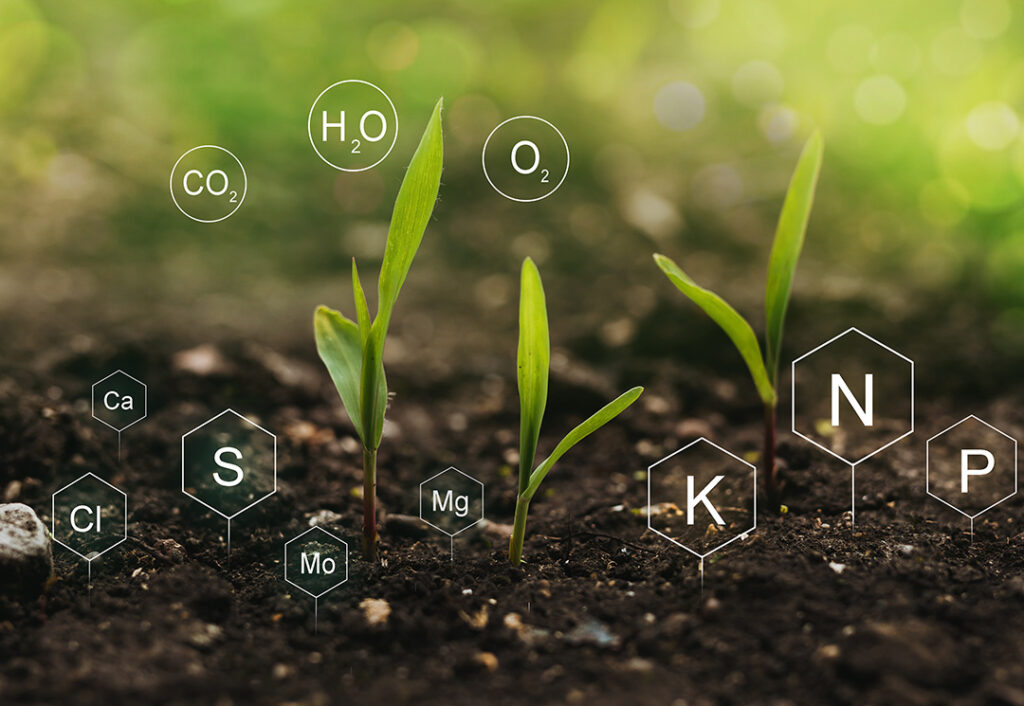Nutrient Mobility

The C. Hopkins café is managed by my cousin Monocle. Now before you mutter some likely hilarious phrases under your breath and click to the next post, hear me out. C. HOPKiNS CaFe Mg B Mn CuZn MoNiCl. It’s a silly mnemonic that I learned in soil fertility class for remembering the 17 essential elements required for plants to grow. Plants get these nutrients from a combination of the air, soil, and water. In healthy plants all 17 nutrients, although differing in their concentrations, have uniform distributions throughout a plant to ensure healthy growth. Knowing what these nutrients are and how they move, both in the soil and inside plants, can help us to make good management choices as farmers who want to grow nutritious food, protect the environment, and be economical throughout the entire process.
Take a minute to scroll through the table on this website by Michigan State University Extension to see the 17 essential elements for plant growth, their elemental symbol, mobility in plants, and an explanation of why they are required for plant growth. As you probably saw from the information on that page, a constant availability of nutrients is extremely important for your crops to be successful. Plus, these nutrient requirements both increase and change in proportion as the plants grow larger and begin fruiting. If you weren’t convinced before, hopefully now you see the importance of understanding nutrient mobility.
Let’s first look at nutrient mobility in soils. 14 of the 17 essential elements must be dissolved in water to be taken in from the soil solution for transportation within the plants. Hopefully you saw in a previous AskAggie post why soils have a negative charge. This charge determines which nutrients can be stored, displaced, and moved within the soil and its solution. Mobility of a nutrient in the soil impacts practical things such as how much of a nutrient can be lost due to leaching or runoff and which nutrients can move to the plants versus having the plants come to them. Nutrient mobility varies amongst the different elements and must be considered when planning fertilizer applications because improper application can increase risks of water contamination and decrease profits. Knowing mobility also determines the likelihood of availability of certain nutrients in the soil for crops during different times of the year. Essentially, the main takeaways are that elements which are very mobile in the soil have a higher chance of runoff issues, but they are also able to move to the plants’ roots. Nutrients that are immobile in the soil are less likely to be removed from the soil by water, but the roots of the plants must physically grow into contact with them. Nutrient mobility in soils:
- Immobile: N as ammonium, P, Mg, Cu, Fe, Zn
- Somewhat Mobile: K, Ca, Mo, Ni
- Mobile: N as nitrate, S, B, Mn, Cl
Next, we look at nutrient mobility in plants. The moveability of elements once inside a plant does not correlate with mobility in soils as just discussed. Once inside plants, the nutrients can be moved to where they are needed and used accordingly. Some nutrients are fixed once they reach their first location while others remain mobile and can be moved around by the plants as needed based on demand. This concept is extremely important for diagnosing plant nutrient deficiencies, which probably all gardeners have encountered at some point. Nutrients considered mobile are transported through the plant via the xylem and phloem. When a plant has a mobile element nutrient deficiency, the symptoms will first appear in older leaves and then move into the new growth as well if not corrected. This is because the plant can move the element from the old growth to the new growth where it is most needed. The opposite is true of immobile nutrients in plants. They are not able to redistribute and can only be transported via xylem. Since these elements cannot move to new areas of active growth, the deficiency shows up in the new growth first and then the older leaves next if not corrected. Nutrient mobility in plants:
- Immobile: Ca, Fe, Zn, Cu, Mn, B, Mo
- Mobile: N, P, K, Mg, S
Nutrient mobility is another complicated topic, but by following Aggie as we understand how our soils and plants interact with one another, we can understand how our crops function, what goes wrong, and the changes needed to grow healthy plants for our communities.
Written by Nikira Lane, agAlaska Ag Tech Specialist


Comments are closed